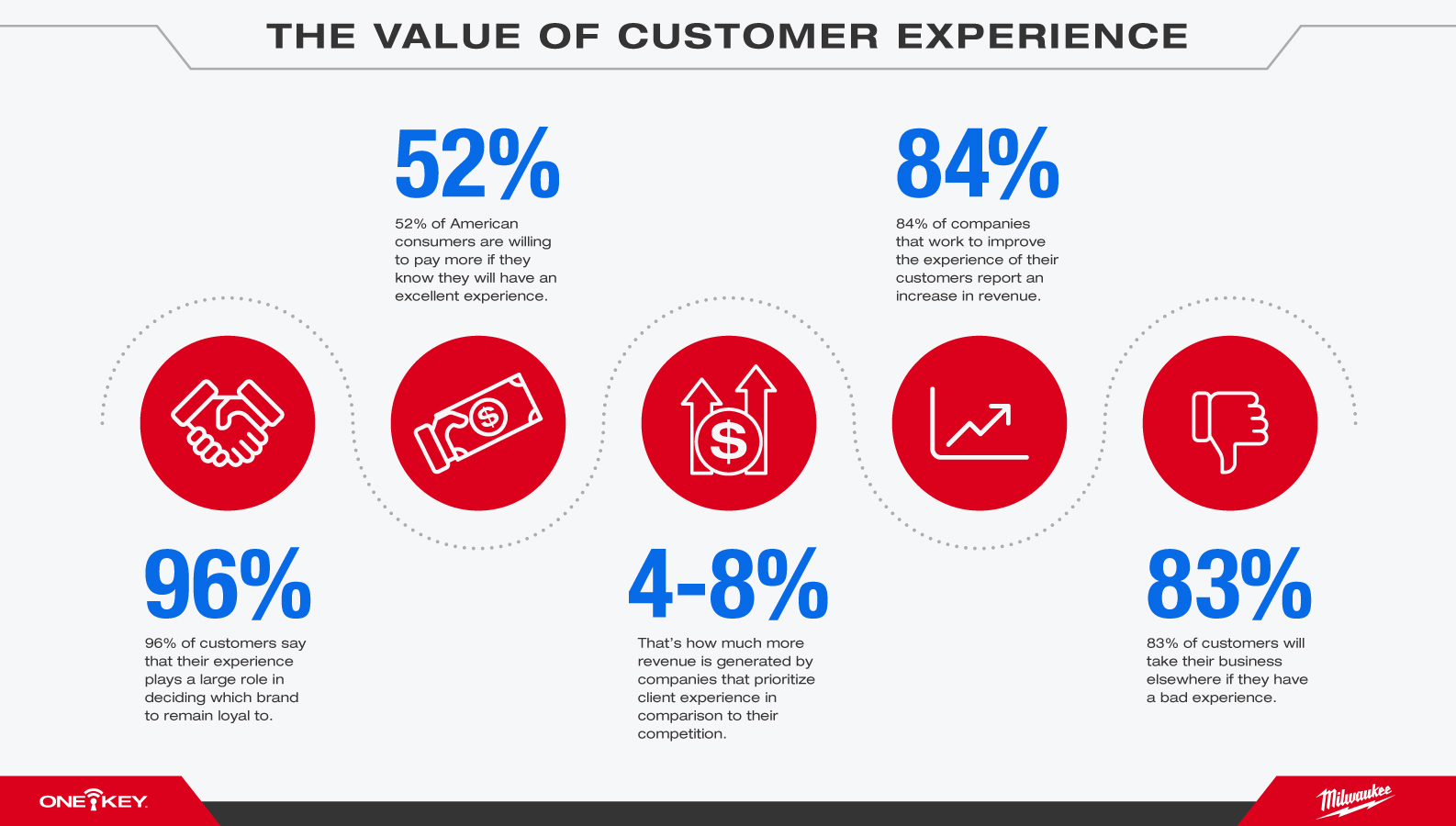
When you think about construction, the first things that likely leap to mind are dented hardhats, heavy toolbelts, spark-spitting power tools, and other such signifiers of a rough and tumble trade. The dust smeared thumbnail is of arduous labor driven by a cold logic of precisely tallied spreadsheets and sharp lines slashed on a blueprint. There is, however, a softer side to construction that remains elusive to any amount of torque or tabulation. This is the magic that makes any profitable enterprise go-round, something we’re keenly aware of here at Milwaukee® Tool, an ingredient so essential that it can make all the difference to whether or not there’s even a jobsite to show up to tomorrow morning.
That’s right, folks. We’re talking about the human element; more specifically, the client experience and the impacts it has–both big and small, overt and subtle–on the nuts-and-bolts work of construction. In this article, we will explain what the client experience is, why it’s so important, and provide some statistics to back up this claim. Finally, we will discuss how to gauge the client experience in your organization and explore some strategies for improving it over time.
What Is the Customer Experience?
Client experience is the totality of a customer’s perceptions, thoughts, and feelings about the quality of a business transaction from its beginning to its end.

A lot goes into the creation of this experience, starting with what a client’s expectations are and the extent to which reality matches up with those expectations from the moment they first make contact. Again, there are many variables at play here, but two primary determinants of a positive or negative client experience are the people they interact with and the quality of the product they receive. Solid construction work delivered on time, within budget, and free of complications equals a high-quality product that will make the customer happy. By the same token, pleasant interactions with affable staff who demonstrate care, an ability to listen, and timely responsiveness to a customer’s reported needs go a long way toward making their experience an overwhelmingly positive one.
5 Reasons Why Customer Experience Is So Important to Construction Projects
Though most often associated with fields like food service and retail, customer experience is just as important to heavy industries like construction. Indeed, perhaps more than any other factor involved, a client’s experience–how happy they are when all is said and done–can make or break a construction business in the long-term. It may seem obvious that happy customers are good for the bottom line, but breaking down the exact elements that go into that statement can help us refine our thinking about how a good client experience is created and where to position it within the hierarchy of your business’ priorities.

Here are five reasons why client experience is important to construction:
1. Happy customers are loyal customers
The happier the client, the more likely they are to return time and time again. It’s a fundamental axiom of any business that a loyal customer is worth their weight in gold, especially in an industry as competitive as construction. Besides boosting revenue, loyal clients add some predictability into the uncertainty of running a construction company, providing a steady source of business that you know you can depend on from one quarter to the next. Remember, clients want to have a good experience, and if you can reliably deliver this, they will reward you for it by sticking with you through thick and thin.
2. Happy clients bring more clients to your business
A happy client is also your most effective advertisement. There’s no publicity more powerful than word-of-mouth marketing. When a client has an overwhelmingly positive experience, they’re much more likely to share that experience with others, whether in the form of social media posts, online reviews, or face-to-face chit-chat with friends and family. All of that free advertisement drives clients to your business. Think about it: It can be difficult for customers to judge the credibility of a company strictly based on brand materials or their own impressions. That’s why positive input from trusted people within their networks can make such a huge difference in their decision to go with contractor A versus contractor B. You want to attract more clients to your construction business? The best place to start is by ensuring that the next person who walks through your door leaves with a smile on their face.
3. Happy customers help you stand out from the pack
People have no shortage of highly qualified options to get the services they want these days, and construction is no exception to this rule. And yet choosing which option to go with can often feel like a high-stake guessing game, whether you’re a homeowner remodeling a kitchen or a municipal government staring down a major capital improvements project. A great way to remove some uncertainty from the equation and differentiate yourself from the competition is to showcase the deep bench of other clients who have nothing but good things to say about you.
4. Happy customers are more likely to pay more
Construction can be a cutthroat business. It’s no secret that a great way to rake in clients is to underbid other contractors, offering the same services for a reduced price. And while fewer zeros are certainly enticing, it’s also established wisdom that you get what you pay for, and cheaper work doesn’t always equal a high-quality finished product. Customers are willing to pay more when they can rest easy in the knowledge that they’re in good hands and their experience will be a positive one.
5. Happy customers improve your business
When a client is happy, it’s a signal to you that you’re doing something right. The flip side of the coin, of course, is that unhappy clients are a glaring red flag that you’re doing something wrong. By gauging the experience of your clients, you can gain deep insights into which areas of your performance are stellar versus those that could use some extra attention.
The Statistics: Quantifying the Value of Customer Experience
Still not convinced? We get it. It can be difficult to see the true value of something as nebulous as client experience in comparison to more tangible investments for your construction business, like a new service vehicle or upgrading your inventory to Milwaukee® Tool’s line of smart ONE-KEY™ compatible power tools.
Maybe you need something a bit more concrete before you decide where to devote your limited resources. If so, look no further. Let’s go to where the rubber meets the road and take a look at what a few of the statistics tell us about the value of the client experience to your construction business.

- 96% of customers say that their experience plays a large role in deciding which brand to remain loyal to.
- 52% of American consumers are willing to pay more if they know they will have an excellent experience.
- 4-8%. That’s how much more revenue is generated by companies that prioritize client experience in comparison to their competition.
- 84% of companies that work to improve the experience of their customers report an increase in revenue.
- 83 % of customers will take their business elsewhere if they have a bad experience.
Customer Experience Measurement: 3 Ways to Gauge Your Customers' Experience
So now that you see the light, you might be wondering how to go about measuring the quality of your clients’ experience.

There are many ways to go about doing this, but here are three that we believe can deliver the best results without requiring you to doom-scroll through online reviews.
1. Analyze in-house data
If you’re not already tracking client metrics, now is the time to start. There is a wealth of big data out there about your customers that can provide you with significant insights into the health of your business and what direction you should be steering toward. How many customer service tickets are created every year? How long does it take for your company to respond to a client’s concerns? How long before an issue is resolved? What kind of client churn does your company experience? That is, how many loyal clients do you retain versus how many switch to a different construction company? How long does it take for clients to jump ship, and are there any common patterns that might reveal where the pain points lie? How much revenue is generated by loyal clients compared to those that come and go? Analyzing in-house data for the answers to these and other questions can sharpen your understanding of how clients experience your specific business over time.
2. Create a customer journey map
Sometimes, a bad experience is bone deep. You can provide the best services and have the most amicable personnel on staff and still, bafflingly, find yourself saddled with a host of clients who walk away with a sour taste in their mouth. This can often happen when clients get lost, confused, or frustrated within the overarching structure of your business. Ask yourself: How much work does an average client have to do on their end to get what they want from my business? How many steps are there between point A and point B? In other words, what kind of journey does the client have to go through? You can put yourself in the client’s shoes by creating what’s called a customer journey map. This is pretty much what it sounds like: A visual representation of each individual step phase of a client’s experience from the moment they learn of your company to the time they purchase a product or service.
By mapping all this out, you can zoom in on individual phases of a client’s journey and identify potential weaknesses and redundancies that can then be corrected. Is your client on a streamlined, easy to navigate path with plenty of helpful signage along the way? Or are they thrust into a labyrinthine wilderness of branching tributaries and blind alleys? A customer journey map can help you see the forest for the trees and develop strategies for trimming or making other process improvements.
3. Conduct client surveys
There’s no better way to figure out what a client wants from their experience than going straight to the source. Surveys are a highly efficient way to get lots of useful feedback from large numbers of people all at once. How does the client rate their experience during each stage of their journey? How likely are they to recommend your services to others? Is there anything in particular that they would like to see improved in your processes? These and many other questions can be answered by communicating directly with your clients.
How to Improve: Implementing a Customer Experience Strategy
Once the soul searching is complete, it’s time to get to work on making improvements.

Here are a few good places to start:
Invest in customer service
One of the biggest changes you can make is what you devote your company’s resources to. If you don’t have a robust customer service department, now might be the time to assemble one. Maybe your website could be streamlined to be more user friendly. Or perhaps your management team and staff could benefit from some extra client service training.
Keep the line open
Again, there’s no better resource for determining the quality of client experience than the clients themselves. Whatever strategies you implement, it pays dividends to make sure that your company is accessible, and that a healthy channel of back-and-forth communication is open between you and your customers. At the risk of belaboring the point, remember that this serves both of your interests: the client wants to have a positive experience and you want to deliver it so that they will spend more, keep coming back, and recommend your services to others.
Empower your employees
Just as you listen to your clients, so too should you listen to your employees. From their position on the front lines, workers have a unique perspective on the systemic problems that plague a client’s experience. Yet all too often, workers in the field feel disempowered to directly address the immediate concerns of clients. The result can be frustration and damaged morale on both sides of the interaction. A good first step to keeping everyone happy is to consult your workers about process improvements. The next thing to do is follow through on making changes as appropriate. Finally, be sure to empower your workers with the tools and freedom they need to address clients’ concerns in real-time.
Focus on building relationships
When we talk about the client experience, what we’re really talking about is how the client feels. So much of how we feel in our day-to-day lives is influenced by the quality of our long-term relationships and social interactions with people in our immediate surroundings. A client might receive a faulty product but still walk away with a positive experience if they feel good about the conversation with the person who fielded their complaint. If you do one thing to improve your client’s experience, focus on ensuring that their interactions are positive with the people within your company. Remember, humans are social animals. This is not an obstacle to be worked around but a strength to be played to.
Bottom Line
It may sometimes go overlooked in this industry, but the truth is that construction professionals rely just as much on the strength and durability of their relationships with clients as they do on the strength and durability of their building materials. As ephemeral as it may seem, there’s plenty of solid evidence that supports the importance of the client experience. Happy customers will return again and again. They will spend more money and their glowing reviews will attract more business to your door.
At the end of the day, you want people to know that they can trust you and that they’re in good hands when they choose you for a project. The best way to guarantee that is to adopt a mindset that places the experience of the client at its center.